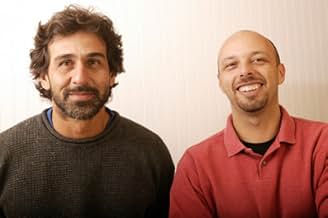IMDb RATING
7.8/10
8.9K
YOUR RATING
On June 12, 2000, a young man with a gun took the passengers aboard Bus 174 in Rio de Janeiro, Brazil hostage. This documentary examines the event itself, the resulting media frenzy, the pol... Read allOn June 12, 2000, a young man with a gun took the passengers aboard Bus 174 in Rio de Janeiro, Brazil hostage. This documentary examines the event itself, the resulting media frenzy, the police response, and the perpetrator's background.On June 12, 2000, a young man with a gun took the passengers aboard Bus 174 in Rio de Janeiro, Brazil hostage. This documentary examines the event itself, the resulting media frenzy, the police response, and the perpetrator's background.
- Directors
- Writers
- Stars
- Awards
- 21 wins & 9 nominations total
Sandro do Nascimento
- Self
- (archive footage)
Geísa Firmo Gonçalves
- Self
- (archive footage)
- Directors
- Writers
- All cast & crew
- Production, box office & more at IMDbPro
Featured reviews
On June 12, 2000 Sandro de Nascimento stepped onto a bus in Rio de Jeneiro, brandished a handgun and demanded money from its patrons. It was just another day in Rio. Well, it was, until an unnecessarily prompt response time by police turned the simple robbery into a complex hostage situation destined to be botched through incompetence. Toss in virtually unrestricted media coverage throughout the five-hour ordeal and what followed was a sequence of dramatized misfortunes to rival the wet dreams of any reality TV producer.
Bus 174, is a documentary by Jose Padilha, focusing on the "how's" and "why's" of the avoidable tragedy that was this day-long fiasco. Relying heavily on in-your-face news footage that was broadcast live to Brazilians around the country; as well as in-depth interviews with hostages, police officers and friends and family of Sandro, Padilha inter-cuts the events of June 12 with the story of Sandro's life as a doomed street kid shunned from society. In so doing, Padilha addresses that age-old ideological argument of nurture vs nature. Did Sandro instigate the events leading to this tragedy of police incompetence simply because it was bread into him? Or might there be more to the story? Had he believed the former, Padihla would have had a much shorter film on his hands. Fortunately for us though, he chose to go against the teachings from the "school of Bush", painting the scenario, not in black and white, but in a muddled gray.
And so we are told the story of a child who, after witnessing the brutal murder of his mother at the age of 5, was destined for a life on the streets where crime is simply a means of survival. We are told of the socio-economical issues in Brazil, where its class system has divided the nation to a point where rich ignore the poor (unless it's to drop slabs of rock on their heads while they sleep). We are told of a government whose brutal attitude towards street kids helped instigate the Candelaria massacres (where Sandro again got to witness the slaying of the people he called family). And we are told of a penal system so inhumane and violent, people would rather die then go to jail. What we are told is that violence begets violence.
As manipulative and subjective as some documentary film-making can be, it is often easy for critics to discredit a film like this as being socialist propaganda (just ask Michael Moore). But it is to Padihla's credit that he is able to avoid this by simply presenting us with the information he has acquired. We are not force-fed opinions and told what to believe, nor is Sandro portrayed as some sort of martyr for equal-rights, we are simply given the full story and are then left to draw our own conclusions.
Because what some may see as black and white, the rest of us see as shades of gray -Shaun English
Bus 174, is a documentary by Jose Padilha, focusing on the "how's" and "why's" of the avoidable tragedy that was this day-long fiasco. Relying heavily on in-your-face news footage that was broadcast live to Brazilians around the country; as well as in-depth interviews with hostages, police officers and friends and family of Sandro, Padilha inter-cuts the events of June 12 with the story of Sandro's life as a doomed street kid shunned from society. In so doing, Padilha addresses that age-old ideological argument of nurture vs nature. Did Sandro instigate the events leading to this tragedy of police incompetence simply because it was bread into him? Or might there be more to the story? Had he believed the former, Padihla would have had a much shorter film on his hands. Fortunately for us though, he chose to go against the teachings from the "school of Bush", painting the scenario, not in black and white, but in a muddled gray.
And so we are told the story of a child who, after witnessing the brutal murder of his mother at the age of 5, was destined for a life on the streets where crime is simply a means of survival. We are told of the socio-economical issues in Brazil, where its class system has divided the nation to a point where rich ignore the poor (unless it's to drop slabs of rock on their heads while they sleep). We are told of a government whose brutal attitude towards street kids helped instigate the Candelaria massacres (where Sandro again got to witness the slaying of the people he called family). And we are told of a penal system so inhumane and violent, people would rather die then go to jail. What we are told is that violence begets violence.
As manipulative and subjective as some documentary film-making can be, it is often easy for critics to discredit a film like this as being socialist propaganda (just ask Michael Moore). But it is to Padihla's credit that he is able to avoid this by simply presenting us with the information he has acquired. We are not force-fed opinions and told what to believe, nor is Sandro portrayed as some sort of martyr for equal-rights, we are simply given the full story and are then left to draw our own conclusions.
Because what some may see as black and white, the rest of us see as shades of gray -Shaun English
Rio de Janeiro, June 12th 2000: it's Valentine's day in Brazil. In Rio's only favela-free middle-class neighborhood (Jardim Botânico), a young black man, drugged and armed, hijacks bus 174 with a dozen passengers in one of Rio's busiest avenues in mid-afternoon. What would have been just one more event in Rio's violence statistics turns out to be a nationwide live-TV horror show. The traffic stops, the elite police surround the area, the bandit threatens to shoot the passengers and then kill himself. The "negotiation" lasts four hours, involves even the governor of Rio de Janeiro state, in what became one of the highest rating events on Brazilian TV history and exposed one of the most stupid and catastrophic police strategies ever devised.
As the negotiation goes on, TV reporters find out that the young hijacker is in fact a survivor of one of Rio's most horrendous crimes: as a young street kid he had escaped being murdered by policemen in the infamous Candelária child mass murder in the early 90s and, instead of being protected by the government, he was sent to a reform unit under appalling conditions (the facilities of the reform unit are some of the most shocking scenes in "Bus 174"). He had also, as a young child, witnessed bandits stab his mother being to death by bandits in front of him.
This powerful documentary includes live TV scenes of the actual hijack and its tragic denouement -- the shooting of one the victims and the bandit's arrest and subsequent assassination by the police, reported then as suicide and eventually proved in court to be manslaughter. It also contains interviews with social workers and sociologists (some of them insightful, others the usual B.S.), shocking interviews with bandits and street kids who knew him, and the testimony of some of the passengers and policemen who were part of the action. If this were a work of fiction, it would be hard to believe, but it's all true.
The opening sequence is especially powerful and revealing: it's one uninterrupted aerial shot of Rio's beautiful shoreline, leading to the imposing mansions of the wealthy, then up to the forest on top of Vidigal hill -- and suddenly the camera tilts downwards and, like a punch in the jaw, we see the immense favela of Rocinha, the largest in Latin America, with some 200,000 inhabitants -- all of that part of the same neighborhood, high-profile wealth and destitute poverty co-existing side by side, sharing the same few square miles.
This is a film that poses a series of difficult questions on violence, public education, social welfare, child abuse, imprisonment policies, juvenile crime, police training and strategy, police abuse, drug addiction, TV ethics and responsibility, the role of social work and rehab, poverty and injustice. No easy answers or solutions here, but very important and disturbing questions all the same.
Do not watch this if you're in search of light entertainment! On the other hand, if you want to know a little bit about what it's like to live in a big city in the Third World -- where the rich and the poor are simultaneously so close (geographically) and far apart (in human and social rights) at the same time -- don't miss it!! If you live in a rich country, prepare to be shocked.
As the negotiation goes on, TV reporters find out that the young hijacker is in fact a survivor of one of Rio's most horrendous crimes: as a young street kid he had escaped being murdered by policemen in the infamous Candelária child mass murder in the early 90s and, instead of being protected by the government, he was sent to a reform unit under appalling conditions (the facilities of the reform unit are some of the most shocking scenes in "Bus 174"). He had also, as a young child, witnessed bandits stab his mother being to death by bandits in front of him.
This powerful documentary includes live TV scenes of the actual hijack and its tragic denouement -- the shooting of one the victims and the bandit's arrest and subsequent assassination by the police, reported then as suicide and eventually proved in court to be manslaughter. It also contains interviews with social workers and sociologists (some of them insightful, others the usual B.S.), shocking interviews with bandits and street kids who knew him, and the testimony of some of the passengers and policemen who were part of the action. If this were a work of fiction, it would be hard to believe, but it's all true.
The opening sequence is especially powerful and revealing: it's one uninterrupted aerial shot of Rio's beautiful shoreline, leading to the imposing mansions of the wealthy, then up to the forest on top of Vidigal hill -- and suddenly the camera tilts downwards and, like a punch in the jaw, we see the immense favela of Rocinha, the largest in Latin America, with some 200,000 inhabitants -- all of that part of the same neighborhood, high-profile wealth and destitute poverty co-existing side by side, sharing the same few square miles.
This is a film that poses a series of difficult questions on violence, public education, social welfare, child abuse, imprisonment policies, juvenile crime, police training and strategy, police abuse, drug addiction, TV ethics and responsibility, the role of social work and rehab, poverty and injustice. No easy answers or solutions here, but very important and disturbing questions all the same.
Do not watch this if you're in search of light entertainment! On the other hand, if you want to know a little bit about what it's like to live in a big city in the Third World -- where the rich and the poor are simultaneously so close (geographically) and far apart (in human and social rights) at the same time -- don't miss it!! If you live in a rich country, prepare to be shocked.
I just saw this movie, and I cannot imagine a more terrifying, sad, and heartbreaking piece of film existing. this movie is simply devastating. I was sobbing within the first 20 minutes. A young man of 19(who looks about 50)hi-jacks a bus and we see the results of an agonizing life play out before our eyes. It is hard to watch, and hard not to deeply care for Sandro. I cannot put into words how heartbreaking and important this movie is. Sandro's life is irrevocably doomed, and we discover there are thousands almost exactly like him, roaming the streets of Rio, desperate and hungry for any kind of social acknowledgement. It should be required viewing for the human race.
This film is an example of in-depth journalism, the way it is not done in the mainstream, commercial media. Instead of focusing on the hijacking of the bus, which is the most attractive footage in this documentary, this documentary decides to explain the context and causes that led the hijacker to perform a suicidal, desperate action, such as hijacking a public bus in the middle of the day. It is an extremely delicate and elaborate work which attempts to present an all-encompassing picture, one that forbids taking sides easily. It is not excusing the perpetrator of the crime in any way, but, still, it is demonstrating how much information we are missing when we, for example, read daily crime reports in newspapers. Instead of playing on the card of the expected outrage over this drug-addicted person who clearly did something extremely wrong, this film will take you several steps further. By showing a more complete frame of Brazilian society in a fierce tour de force, the authors of this film make the spectator question his or hers opinions and attitudes over and over again. It is a documentary that sticks with you for more than one day.
One of those moments when you realise that you know nothing about the roots of another culture or society. And when you start learning, the pits of your stomach heave and your heart collapses at the deplorable and impossibly harsh reality of other people's lives.
Onibus 174 is the piecing together of an event that took place in 2000 in Rio de Janeiro, where a gunman took a busload of passengers hostage. The whole event was televised live to the nation, and this documentary film uses this footage, along with interviews with survivors, friends and relatives of the gunman, to document the implications of a society that treats its poor with a disdain not even reserved for deformed animals.
I can honestly say I have never sat through a film that was as difficult to watch as this. Throughout most of it my stomach clenched with anxiety, pity, misery and sadness. I cried at the plight of the street kids. I cried at the description of the child seeing his mother being stabbed 3 times and crawling about with a kitchen knife sticking out of her shoulder until she died in front of him. I cried at the last moments of the hijacking. And I cried at the reaction of the baying, blood-thirsty crowd of on-lookers at the end. And all this from live images. As it happened. The crude, devastating vicissitudes of a society wracked with poverty and hardship.
I have no idea why this film affected me so profoundly, but there's no doubt that is was largely to do with witnessing the real effects of social meltdown. The street kids are merely trying to gather together the semblance of an existence. Suddenly the thefts and muggings became understandable; I could be swayed to be not just sympathetic towards, but defensive of their crime, such is the extent of their horrendous degradation. And this is the result of rendering them invisible.
A film that's devastating, enlightening and enfuriating in equal parts. It has to be watched, but beware that it'll make you all too aware of your own impotence.
Onibus 174 is the piecing together of an event that took place in 2000 in Rio de Janeiro, where a gunman took a busload of passengers hostage. The whole event was televised live to the nation, and this documentary film uses this footage, along with interviews with survivors, friends and relatives of the gunman, to document the implications of a society that treats its poor with a disdain not even reserved for deformed animals.
I can honestly say I have never sat through a film that was as difficult to watch as this. Throughout most of it my stomach clenched with anxiety, pity, misery and sadness. I cried at the plight of the street kids. I cried at the description of the child seeing his mother being stabbed 3 times and crawling about with a kitchen knife sticking out of her shoulder until she died in front of him. I cried at the last moments of the hijacking. And I cried at the reaction of the baying, blood-thirsty crowd of on-lookers at the end. And all this from live images. As it happened. The crude, devastating vicissitudes of a society wracked with poverty and hardship.
I have no idea why this film affected me so profoundly, but there's no doubt that is was largely to do with witnessing the real effects of social meltdown. The street kids are merely trying to gather together the semblance of an existence. Suddenly the thefts and muggings became understandable; I could be swayed to be not just sympathetic towards, but defensive of their crime, such is the extent of their horrendous degradation. And this is the result of rendering them invisible.
A film that's devastating, enlightening and enfuriating in equal parts. It has to be watched, but beware that it'll make you all too aware of your own impotence.
Did you know
- TriviaIncluded among the 1,001 Movies You Must See (Before You Die) (2014), edited by Steven Schneider.
- ConnectionsFeatured in 50 Documentaries to See Before You Die: Episode 4 (2011)
- How long is Bus 174?Powered by Alexa
Details
Box office
- Gross US & Canada
- $217,201
- Opening weekend US & Canada
- $8,625
- Oct 12, 2003
- Gross worldwide
- $222,506
- Runtime
- 2h 30m(150 min)
- Color
- Sound mix
- Aspect ratio
- 1.85 : 1
Contribute to this page
Suggest an edit or add missing content








